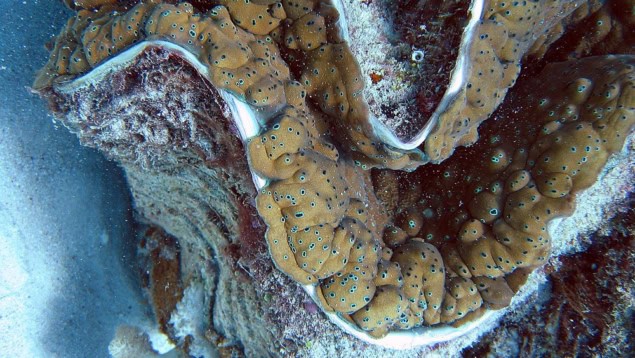
I think it’s safe to say that photosynthesis is one of the most important biochemical processes at work here on Earth – and possibly elsewhere in the universe. I know that it is chemistry, but physicists have long had a fascination with the process. They include Yale University’s Amanda Holt and Alison Sweeney, who have teamed up with the marine scientist Lincoln Rehm of Drexel University to study how a symbiotic relationship between giant clams and algae makes extremely efficient use of sunlight.
The photosynthesizing algae reside on the mantle of the clam. This is a cloak-like structure between the two shells of the clam. The algae produce organic molecules that provide energy to the clam. In return, the clam uses its filter-feeding system to provide the algae with nitrogen and other nutrients.
What makes this relationship interesting is how efficient it is at converting sunlight into chemical energy. At the cellular level, photosynthesis is nearly 100% efficient in converting sunlight. But when it occurs in a large-scale system like a field of crops or an ecosystem, this efficiency drops to about 3%. In contrast, giant clam/algae systems are known to achieve efficiencies as high as 67%. Now, Holt, Sweeney and Rehm may have discovered why.
Vertical pillars
Within the mantle, the algae cells are arranged in vertical pillars that are about 0.1 mm in diameter. The pillars sit below a thin translucent membrane, which the trio had previously shown scatters sunlight into the horizontal plane – thereby illuminating the sides of the pillars.
New simulations and calculations done by the researchers suggest that this pillar design should achieve a conversion efficiency of about 43% in bright tropical sunlight. Eager to understand why their analysis came up short of the measured value of 67%, the trio then looked at how the clam changes the spacing between the pillars as light levels change throughout the day. By integrating these dynamics into their model, they were able to reproduce the 67% figure.
The scientists report their findings in Physical Review D. You can read an accompanying description of the research in Physics, in which Mark Buchanan also explains how the research could boost our understanding of other living systems that harvest sunlight – and could lead to better solar cells.
If this work has piqued your interest in the physics of photosynthesis, check out “Is photosynthesis quantum-ish?”, by the science writer Philip Ball. This feature article looks at the debate surrounding the role that quantum physics plays in photosynthesis.


